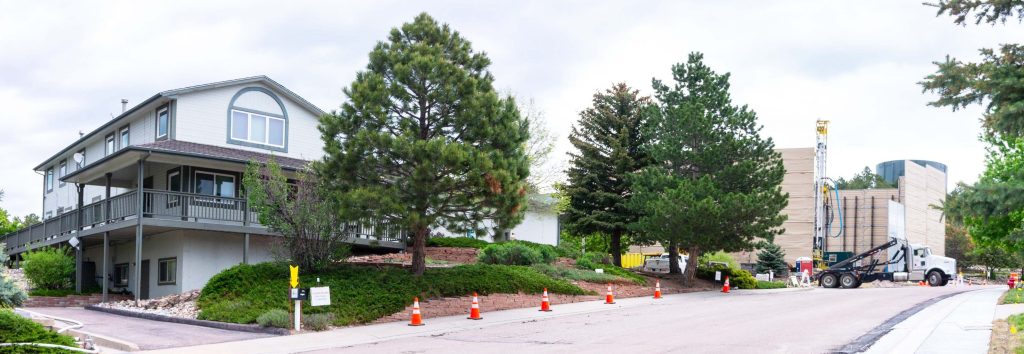- Wastewater treatment facility tour
- Bills adjusted for snowbirds and leaks
- Operational Reports
- Executive session
By James Howald and Jackie Burhans
The Donala Water and Sanitation District (DWSD) board met in July at the Upper Monument Creek Regional Wastewater Treatment Facility (UMCRWWTF) to tour the facility and to amend the policies by which sewer bills are calculated in two problem cases. The board also heard operational reports and held an executive session.
Wastewater treatment facility tour
Waste Plant Operator Aaron Tolman led the board on a tour of the UMCRWWTF, which is located at 14770 Jumping Mouse View. He highlighted the facility’s Programmable Logic Controller (PLC), which was upgraded over the past year. The PLC controls the operation of the treatment facility and is the center of its Supervisory Control and Data Acquisition (SCADA) system. The PLC upgrades provide more granular control over the facility’s components and processes and replaced manual controls with more precise digital controls, resulting in savings on energy costs and adding redundancy to operations. The upgrades also improve the purity of the effluent that is released into Monument Creek. Board President Wayne Vanderschuere said the upgrades were also designed to improve the cybersecurity of the facility.


Bills adjusted for snowbirds and leaks
At the July meeting, the board voted on Resolution 2025-4, which changes the way sewer bills are calculated for customers who have water leaks or who spend the winter months outside the district. The changes were discussed in detail at the board meeting in May. That discussion can be found here: https://wp.ocn.me/v25n6dwsd/.
DWSD uses water consumption during the winter months to calculate each customer’s sewer bill. This method assumes that none of the water used during the winter months is used for irrigation and, therefore, during the winter months, a gallon of water used creates a gallon of wastewater. This method creates two problem cases: if a customer has a water leak during the winter months, that results in too high a charge for sewer service, and if a customer spends the winter months outside the district, that results in too low a charge. The resolution provides for a Water Leak Adjustment program to address the first case and specifies that the district’s annual lower quartile consumptive average will be used to calculate sewer bills in the second case.
Vanderschuere pointed out that no changes were being made to rates.
The board voted unanimously in favor of the resolution.
Operational Reports
In his Manager’s Report, General Manager Jeff Hodge suggested the district hold an open house for customers as part of the district’s public outreach efforts. The open house would be an opportunity to thank residents living near the Well 7D drilling site for their patience and understanding for the disruption caused by the drilling operation, and a chance to educate the public about the district’s operations. He proposed Thursday, Sep. 25 from 4 to 7 p.m. for the open house.
Hodge also updated the board on the status of the Well 7D redrilling project. The well is done, he said, and water testing is underway. Helen Malenda-Lawrence of LRE Water is calculating the amount the district’s water rights will allow it to pump from the well. The Colorado Department of Health and the Environment will need to provide the permit for the well. Preliminary tests show good water quality, Hodge said, adding he expected the well to produce 200 gallons per minute.
In his Water Report, Superintendent of Water Operations Ronny Wright told the board repair work on the lid of the east water tank was complete and the next step would be to sandblast the west water tank.
In his Wastewater Report, Tolman said Timberline Building Systems had installed an ultrasonic flow transducer in the flume through which the UMCRWWTF discharges treated effluent into Monument Creek. The transducer is integrated with the facility’s SCADA system.
Executive session
The meeting ended with an executive session to receive legal advice from counsel regarding the district’s pending water court application in Case No. 24CW3019.
**********
The next board meeting has been moved to Thursday, Aug. 14 at 1:30 p.m. Generally, board meetings are held the third Thursday of the month at 1:30 p.m. and include online access; call (719) 488-3603 or access www.donalawater.org to receive up-to-date meeting information. The district office is located at 15850 Holbein Drive, Colorado Springs.
James Howald can be reached at jameshowald@ocn.me. Jackie Burhans can be reached at jackieburhans@ocn.me
Other Donala Water and Sanitation District articles
- Donala Water and Sanitation District, July 17 – Board tours treatment facility, adjusts sewer bills (8/1/2025)
- Donala Water and Sanitation District, June 12 – Positive audit report; inconsistent waste treatment numbers (7/3/2025)
- Donala Water and Sanitation District, May 5 – Directors sworn in; district offices temporarily closed (6/7/2025)
- Donala Water and Sanitation District, April 17 – Workshop covers finances, water supply (5/3/2025)
- Donala Water and Sanitation District, Mar. 27 – New water and sewer rates take effect (4/5/2025)
- Donala Water and Sanitation District, Feb. 20 – Voters remove term limits (3/1/2025)
- Donala Water and Sanitation District, Jan. 16 – Board passes housekeeping resolution (2/1/2025)
- Donala Water and Sanitation District, Nov. 21 – State signs off on radium remediation (1/4/2025)
- Donala Water and Sanitation District, Nov. 21 – Board hears rate and groundwater supply studies (12/5/2024)
- Donala Water and Sanitation District, Oct. 10 – Board receives preliminary 2025 budget, considers rate increase (11/2/2024)









